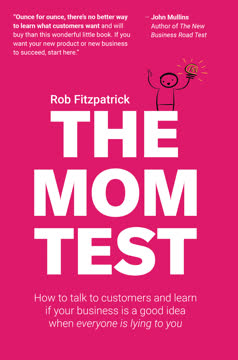Key Takeaways
1. Platforms revolutionize industries by enabling value-creating interactions
A platform is a business based on enabling value-creating interactions between external producers and consumers.
Fundamental shift in business models. Platforms are transforming entire sectors of the economy by facilitating connections between producers and consumers. Unlike traditional pipeline businesses that create and deliver value linearly, platforms create value by enabling interactions between participants. This allows platforms to scale rapidly and efficiently.
Three key exchanges. Platform interactions typically involve three types of exchanges:
- Information exchange (e.g. product listings, user profiles)
- Exchange of goods/services
- Exchange of currency (money or other forms of value like attention)
Industry examples. Platforms are disrupting diverse industries:
- Transportation: Uber connects riders and drivers
- Hospitality: Airbnb connects travelers and hosts
- Retail: Amazon Marketplace connects buyers and sellers
- Media: YouTube connects content creators and viewers
2. Network effects drive platform growth and competitive advantage
Positive network effects are the main source of value creation and competitive advantage in a platform business.
Virtuous cycle of growth. Network effects create a powerful feedback loop:
- More users attract more users
- More producers attract more consumers and vice versa
- Value of the platform increases for all participants as it grows
Types of network effects. Platforms experience four types of network effects:
- Same-side positive (e.g. more Facebook users attract more users)
- Same-side negative (e.g. too many sellers on eBay increases competition)
- Cross-side positive (e.g. more Uber drivers attract more riders)
- Cross-side negative (e.g. too many ads on Facebook annoy users)
Competitive advantage. Strong network effects create high barriers to entry for competitors. This allows successful platforms to achieve dominant market positions rapidly. For example, Facebook quickly overtook MySpace by leveraging superior network effects.
3. Successful platforms balance openness with control
Platform managers need to continually monitor their platforms' boundaries between openness and closedness and ensure they are set appropriately.
Spectrum of openness. Platforms must decide how open or closed to be across multiple dimensions:
- Access (who can participate)
- Development (who can build on the platform)
- Commercialization (who can profit from the platform)
Trade-offs of openness. More openness can:
- Accelerate innovation and growth
- Increase value creation
- Reduce platform control
- Create quality/trust challenges
Finding the right balance. Successful platforms:
- Open gradually over time as they grow
- Maintain control over core functions
- Create rules and standards for participation
- Use curation to maintain quality
Examples:
- Apple's iOS: Relatively closed, tightly controlled
- Android: More open, allows customization by manufacturers
- Linux: Fully open source
4. Effective platform design focuses on core interactions and user experience
Platforms are designed one interaction at a time. Thus, the design of every platform should start with the design of the core interaction that it enables between producers and consumers.
Core interaction components:
- Participants: Producers and consumers
- Value unit: The core content or service exchanged
- Filter: Tools to enable relevant exchanges
Key platform functions:
- Pull: Attract participants to the platform
- Facilitate: Provide tools for easy interactions
- Match: Connect the right producers and consumers
User experience principles:
- Reduce friction in joining and using the platform
- Create feedback loops to encourage engagement
- Enable easy value creation by producers
- Provide effective curation and search for consumers
Design evolution. Successful platforms:
- Start with a single high-value core interaction
- Gradually add new interactions and features
- Maintain a stable core while enabling variety at the edges
5. Platform businesses face unique monetization challenges and opportunities
Monetizing network effects poses a unique challenge. Network effects make a platform attractive by creating self-reinforcing feedback loops that grow the user base, often with minimal effort or investment by the platform manager.
Monetization strategies:
- Transaction fees (e.g. Airbnb, eBay)
- Subscription fees (e.g. LinkedIn Premium)
- Advertising (e.g. Facebook, Google)
- Freemium model (e.g. Spotify)
- Enhanced access or features (e.g. dating apps)
Key considerations:
- Avoid discouraging participation with early monetization
- Identify which side of the market is most price-sensitive
- Leverage data to create additional value
- Capture value from interactions happening on the platform
Timing is crucial. Platforms often focus on growth before monetization. They may subsidize one side of the market to attract participants. Monetization strategies evolve as the platform matures and network effects strengthen.
6. Platforms disrupt traditional business models and reshape competition
Platforms beat pipelines because platforms scale more efficiently by eliminating gatekeepers.
Competitive advantages of platforms:
- Lower marginal costs of scaling
- Ability to tap into external resources
- Data-driven optimization and personalization
- Rapid innovation through third-party developers
Industry transformation examples:
- Retail: Amazon vs. traditional stores
- Media: YouTube vs. television networks
- Transportation: Uber vs. taxis
- Hospitality: Airbnb vs. hotels
Strategic implications for incumbents:
- Shift focus from controlling internal resources to orchestrating external ecosystems
- Leverage existing assets and customer relationships
- Identify opportunities to platformize parts of the business
- Partner with or acquire emerging platforms
7. Launching a platform requires overcoming the chicken-or-egg problem
Most platforms fail simply because they never overcome this problem.
The challenge: Platforms need both producers and consumers to create value, but neither wants to join without the other side present.
Launch strategies:
- Follow-the-rabbit: Build on an existing user base
- Piggyback: Leverage an existing platform's users
- Seeding: Create initial value to attract first users
- Marquee: Subsidize key participants to join
- Single-side: Focus on one side before adding the other
- Producer evangelism: Enlist producers to bring their customers
- Big-bang adoption: Use traditional marketing for simultaneous onboarding
- Micromarket: Start with a small, connected group of users
Key principles:
- Reduce friction for early adopters
- Create value for users even with small network size
- Use incentives strategically to attract key participants
- Design for viral growth
8. Data and algorithms are key assets for platform businesses
Well-designed platforms create mutually rewarding matches on a consistent basis. As such, continual improvement of data acquisition and analysis methods is an important challenge for any organization seeking to build and maintain a platform.
Data as a competitive advantage:
- Enables better matching of producers and consumers
- Improves platform efficiency and user experience
- Provides insights for platform optimization and innovation
- Creates barriers to entry for competitors
Key data types:
- User profiles and preferences
- Interaction history and patterns
- Content and product information
- Real-time usage data
Leveraging data and algorithms:
- Personalize recommendations and search results
- Optimize pricing and resource allocation
- Detect and prevent fraud or misuse
- Identify trends and opportunities for new features
Challenges:
- Balancing data collection with user privacy
- Ensuring data quality and relevance
- Developing and maintaining effective algorithms
- Managing data as a strategic asset
9. Platform governance balances innovation with trust and safety
Good governance means looking after the health of one's ecosystem partners.
Key governance functions:
- Setting rules for participation
- Maintaining quality standards
- Resolving disputes between participants
- Aligning incentives for value creation
Governance tools:
- Terms of service and community guidelines
- Reputation and rating systems
- Content moderation
- Incentive structures (e.g. revenue sharing)
Balancing act:
- Openness vs. control
- Innovation vs. standardization
- Growth vs. quality
- Platform interests vs. participant interests
Trust and safety considerations:
- Identity verification
- Fraud prevention
- Dispute resolution
- Data privacy and security
10. The future economy will be dominated by platform ecosystems
Platform Revolution is our attempt to provide the first clear, complete, authoritative guide to one of the most important economic and social developments of our time—the rise of the platform as a business and organizational model.
Expanding platform impact. Platforms are poised to transform additional industries:
- Healthcare
- Education
- Energy
- Finance
- Government services
Emerging trends:
- Integration of AI and machine learning
- Growth of the Internet of Things (IoT)
- Blockchain and decentralized platforms
- Augmented and virtual reality experiences
Societal implications:
- Changes in nature of work and employment
- Shifts in power dynamics between companies, consumers, and regulators
- New challenges for privacy, security, and economic equality
- Potential for increased innovation and economic growth
Preparing for the platform future:
- Develop platform thinking and digital skills
- Understand network effects and ecosystem dynamics
- Consider how your industry might be platformized
- Explore opportunities to participate in or create platforms
Last updated:
FAQ
What's Platform Revolution about?
- Focus on Platforms: Platform Revolution explores how platforms like Airbnb, Uber, and Amazon have transformed traditional industries by connecting producers and consumers through technology.
- Economic and Social Impact: It examines the broader implications of platforms on markets and industries, highlighting their role in reshaping competition and economic growth.
- Practical Guide: The book serves as a comprehensive guide for understanding and leveraging the platform model, aimed at business leaders, entrepreneurs, and policymakers.
Why should I read Platform Revolution?
- Understanding Modern Economy: The book provides insights into the fundamental changes in the economy driven by platform businesses, affecting sectors from healthcare to education.
- Strategic Insights: It offers practical strategies for launching and managing successful platforms, addressing challenges like the chicken-or-egg problem with actionable advice.
- Expert Perspectives: Authored by experts Geoffrey G. Parker, Marshall W. Van Alstyne, and Sangeet Paul Choudary, it combines academic rigor with real-world examples for a well-rounded understanding.
What are the key takeaways of Platform Revolution?
- Network Effects: The book emphasizes the importance of network effects, where a platform's value increases as more users join, creating a self-reinforcing growth cycle.
- Openness and Control: It discusses the balance between openness and control in platform governance, stressing the need for effective curation to maintain quality.
- Monetization Strategies: Various monetization strategies are outlined, including transaction fees and enhanced access, with a focus on capturing value without discouraging participation.
What is the chicken-or-egg problem in platforms according to Platform Revolution?
- Definition: The chicken-or-egg problem involves attracting users on both sides of a platform when each side depends on the other for value.
- Strategies to Overcome: Strategies include the follow-the-rabbit approach, where a non-platform project demonstrates success, and seeding the platform with initial content or users.
- User Commitment: Emphasizes that user commitment and active participation are more important than mere sign-ups, requiring platforms to design incentives for ongoing engagement.
How do platforms create value according to Platform Revolution?
- Facilitating Interactions: Platforms enable interactions between producers and consumers, allowing exchanges of information, goods, services, and currency.
- Leveraging Network Effects: As more users join, the value for each user increases, leading to positive network effects and enhancing the platform's growth potential.
- Access to Resources: Platforms provide tools, services, and curated content that facilitate interactions, enhancing user experience and encouraging participation.
What are the different types of network effects discussed in Platform Revolution?
- Positive Network Effects: Occur when an increase in users leads to greater value for all participants, such as more drivers on Uber attracting more riders.
- Negative Network Effects: Arise when growth leads to decreased value, often due to overcrowding or poor quality, like difficulty finding matches on a crowded dating platform.
- Same-Side and Cross-Side Effects: Distinguishes between same-side effects (impact on users of the same side) and cross-side effects (impact of one side on the other), both influencing platform dynamics.
How can platforms monetize their services according to Platform Revolution?
- Transaction Fees: Platforms can charge fees based on the value created through interactions, capturing value without discouraging participation.
- Enhanced Access Fees: Charging for enhanced visibility or access to consumers can generate revenue while maintaining a free tier for general users.
- Subscription Models: Offering premium features or services for a fee can create a steady revenue stream while providing additional value to users.
What is the role of governance in platform management as discussed in Platform Revolution?
- Defining Participation Rules: Governance involves establishing rules for participation and value distribution, ensuring fair value creation and capture.
- Balancing Openness and Control: Finding the right balance is crucial; too much openness can lead to quality issues, while too much control can stifle participation.
- Conflict Resolution: Includes mechanisms for resolving conflicts among users, maintaining a fair and productive environment to ensure user trust and engagement.
What are the principles of smart self-governance for platforms in Platform Revolution?
- Internal Transparency: Emphasizes clear communication and visibility across all divisions to prevent siloed thinking and promote collaboration.
- Participation of External Partners: Engaging external stakeholders in decision-making builds trust and loyalty within the ecosystem.
- Adaptability and Evolution: Governance mechanisms should be flexible to adapt to changing market conditions and user behaviors for long-term success.
How does Platform Revolution suggest platforms can innovate and capture value?
- Encouraging Partner Innovation: Creating an environment for external developers to innovate freely benefits all participants.
- Capturing Value through Acquisition: Strategically acquiring successful partner innovations can enhance the platform's value proposition.
- Leveraging Data for Insights: Using data from user interactions to identify trends and opportunities for new services helps platforms stay competitive.
What challenges do platforms face in governance as discussed in Platform Revolution?
- Managing Externalities: Platforms must address negative externalities affecting third parties, considering the broader impact on communities and stakeholders.
- Balancing Stakeholder Interests: Navigating competing interests of users, developers, and investors is crucial for maintaining a healthy ecosystem.
- Adapting to Regulations: Platforms must be agile in responding to changing regulations and public expectations for long-term viability.
What are the best quotes from Platform Revolution and what do they mean?
- "Beautiful, useful ideas are public goods.": Highlights the importance of sharing innovative concepts to foster collaboration and innovation within platform ecosystems.
- "Good governance means looking after the health of one’s ecosystem partners.": Emphasizes the responsibility of platform managers to ensure all participants thrive, balancing stakeholder interests.
- "Markets can govern behavior through the use of mechanism design and various incentives.": Reflects the role of well-designed market mechanisms and incentives in influencing user behavior positively.
Review Summary
Platform Revolution receives mixed reviews, with an average rating of 4.05/5. Readers appreciate its comprehensive analysis of platform businesses, network effects, and real-world examples. Many find it insightful for entrepreneurs and managers. However, some criticize its writing style, repetitiveness, and lack of critical analysis. The book is praised for its thorough examination of platform design, growth strategies, and governance. Critics note its focus on business aspects rather than societal impacts. Overall, it's considered valuable for those interested in platform economics and digital business models.
Similar Books










Download PDF
Download EPUB
.epub digital book format is ideal for reading ebooks on phones, tablets, and e-readers.




